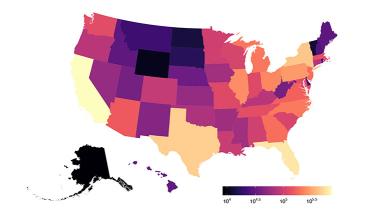New research shows some of the highest levels of Alzheimer's disease in the U.S. are in parts of the South and Northeast.
The research results, published July 17 in Alzheimer’s & Dementia: The Journal of the Alzheimer’s Association, show the first-ever county-level estimates of people living with Alzheimer’s disease in all U.S. counties.
“Some regions had higher percentages of minority residents living with Alzheimer’s,” said Kumar B. Rajan, PhD, professor in the Department of Internal Medicine at RUSH Medical College and director of the RUSH Institute for Healthy Aging.
“Having this information can help guide decision-making and the allocation of resources and health programs aimed at helping those with dementia in the areas where they’re needed most.”
Rajan and colleagues used cognitive data from the Chicago Health and Aging Project and National Center for Health Statistics estimates of adults 65 years and older with Alzheimer’s in 3,142 counties within the 50 states.
Highest rates in Florida, Maryland, New York
The study estimates that in counties with a population of 10,000 or more, Alzheimer’s prevalence among people who are 65 years and older is highest in these counties:
- Miami-Dade County, Florida (16.6%)
- Baltimore County, Maryland (16.6%)
- Bronx County, New York (16.6%)
- Prince George’s County, Maryland (16.1%)
- Hinds County, Mississippi (15.5%)
- Orleans Parish, Louisiana (15.4%)
- Dougherty County, Georgia (15.3%)
- Orangeburg County, South Carolina (15.2%)
- Imperial County, California (15.0%)
- El Paso County, Texas (15.0%)
Rajan and his research team noted a combination of specific demographic characteristics that may explain the higher rates in these counties, including an older average age and higher percentages of Black and Hispanic residents. For example, Bronx County in New York had an Alzheimer's prevalence rate of 14%, and the county has a large number of residents older than 85 and a population of 30% Black and 47% Hispanic.
Age is well-established as a primary risk factor for Alzheimer’s and is far more common among Black and Hispanic Americans. According to Alzheimer’s Association 2023 data, older Black Americans are twice as likely to have Alzheimer’s or other dementias as older whites, and older Hispanic Americans are one and one-half times as likely to have Alzheimer’s or other dementias as older whites.
“These new estimates add more granular data to our understanding of Alzheimer’s prevalence across the country,” Rajan said. “Alzheimer’s dementia is a multifactorial disease involving several risk characteristics that interact with demographic risk factors and ultimately contribute to the prevalence.”
More research planned
The authors note a limitation of the study is that these estimates are computed based on the distribution of demographic risk factors, while there are many other risk factors (e.g., lifestyle factors, genetics) that can modify Alzheimer's risk. They plan to extend this research by working closely with several epidemiological studies in the U.S. to understand better the risk factors associated with Alzheimer’s disease variability across the U.S.
An estimated 6.7 million Americans are living with Alzheimer’s disease, according to the Alzheimer’s Disease Facts and Figures report. Based on previous projections, the report shows the West and Southwest regions of the U.S. will experience the largest percentage increase in people living with Alzheimer’s dementia between 2020 and 2025.
The study also was presented at the Alzheimer’s Association International Conference in Amsterdam, Netherlands, the world’s largest gathering of researchers from around the world focused on Alzheimer’s and other dementias.




